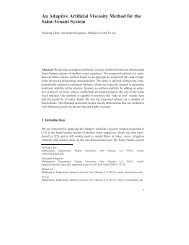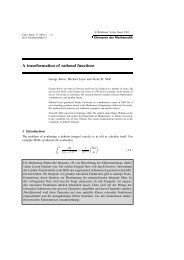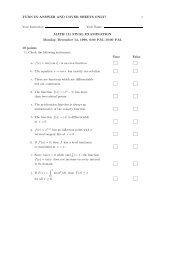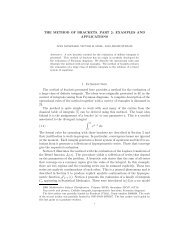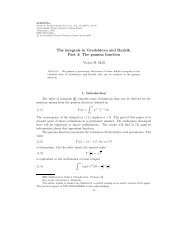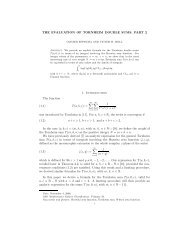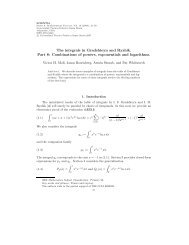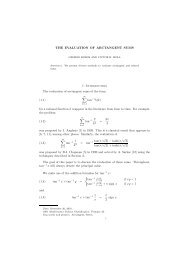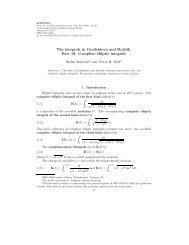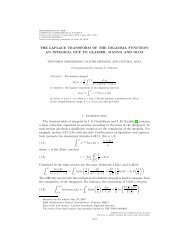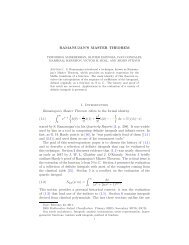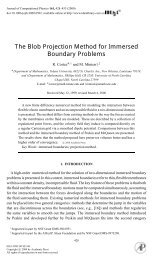ON SOME INTEGRALS INVOLVING THE HURWITZ ZETA FUNCTION
ON SOME INTEGRALS INVOLVING THE HURWITZ ZETA FUNCTION
ON SOME INTEGRALS INVOLVING THE HURWITZ ZETA FUNCTION
Create successful ePaper yourself
Turn your PDF publications into a flip-book with our unique Google optimized e-Paper software.
<strong>ON</strong> <strong>SOME</strong> <strong>INTEGRALS</strong> <strong>INVOLVING</strong> <strong>THE</strong> <strong>HURWITZ</strong> <strong>ZETA</strong><br />
FUNCTI<strong>ON</strong>: PART 2<br />
OLIVIER ESPINOSA AND VICTOR H. MOLL<br />
Abstract. We establish a series of integral formulae involving the Hurwitz<br />
zeta function. Applications are given to integrals of Bernoulli polynomials,<br />
log Γ(q) and log sin(q).<br />
(1.1)<br />
The Hurwitz zeta function, defined by<br />
1. Introduction<br />
ζ(z, q) =<br />
∞∑<br />
n=0<br />
1<br />
(n + q) z<br />
for z ∈ C, Re z > 1 and q ≠ 0, −1, −2, · · · admits the integral representation<br />
(1.2)<br />
ζ(z, q) =<br />
1<br />
Γ(z)<br />
∫ ∞<br />
0<br />
e −qt<br />
1 − e −t tz−1 dt,<br />
where Γ(z) is Euler’s gamma function, which is valid for Re z > 1 and Re q > 0,<br />
and can be used to prove that ζ(z, q) admits an analytic extension to the whole<br />
complex plane except for a simple pole at z = 1. Hermite proved the alternative<br />
integral representation<br />
(1.3)<br />
(1.4)<br />
ζ(z, q) = 1 2 q−z + 1<br />
∫ ∞<br />
z − 1 q1−z + 2q 1−z sin(z tan −1 t) dt<br />
(1 + t 2 ) z/2 (e 2πtq − 1) .<br />
The Fourier representation of ζ(z, q)<br />
ζ(z, q) =<br />
(<br />
2Γ(1 − z)<br />
(2π) 1−z × sin<br />
( πz<br />
) ∑ ∞<br />
cos(2πqn)<br />
2 n 1−z + cos<br />
n=1<br />
0<br />
( πz<br />
) ∞<br />
)<br />
∑ sin(2πqn)<br />
2 n 1−z ,<br />
n=1<br />
valid for Re z < 0 and 0 < q < 1, is due to Hurwitz and is derived in [10], page 268.<br />
A proof of (1.4) based upon the representation<br />
(1.5)<br />
∫ ∞<br />
ζ(z, q) = q1−z<br />
z − 1 + q−z<br />
2 − z {t} − 1 2<br />
dt,<br />
(t + q)<br />
z+1<br />
where {t} is the fractional part of t, has been given by Berndt [2]. The expression<br />
(1.5) is employed in [2] to give short proofs of several classical formulae, including<br />
Date: May 22, 2001.<br />
1991 Mathematics Subject Classification. Primary 33.<br />
Key words and phrases. Hurwitz zeta function, polylogarithms, loggamma, integrals.<br />
1<br />
0
2 OLIVIER ESPINOSA AND VICTOR H. MOLL<br />
Lerch’s beautiful expression<br />
(1.6)<br />
ln Γ(q) = ζ ′ (0, q) − ζ ′ (0).<br />
In this paper we continue the work, initiated in [6], on the explicit evaluation of<br />
integrals involving ζ(z, q). Special cases of ζ(z, q) include the Bernoulli polynomials<br />
(1.7)<br />
defined by their generating function<br />
(1.8)<br />
B m (q) = −mζ(1 − m, q), m ∈ N,<br />
te qt<br />
e t − 1<br />
=<br />
∞∑<br />
B m (q) tm m!<br />
m=0<br />
and given explicitly in terms of the Bernoulli numbers B k by<br />
m∑<br />
( ) m<br />
(1.9)<br />
B m (q) = B k q m−k .<br />
k<br />
k=0<br />
(2.1)<br />
2. The function A k (q) and its special values<br />
In this section we consider the function<br />
A k (q) := d dz ζ(z, q) ∣<br />
∣∣z=−k<br />
for k ∈ N. These functions appear in all of the formulae for the indefinite integrals<br />
involving the loggamma and the logsine functions studied in Section 3.<br />
The transcendental behavior of A k (q) can be considered to be contained in the<br />
range 0 ≤ q ≤ 1, since for q > 1 the value of A k (q) can be obtained by repeated<br />
use of the following result:<br />
Lemma 2.1. The function A k (q) satisfies<br />
(2.2)<br />
A k (q + 1) = A k (q) + q k ln q.<br />
Proof. Differentiate both sides of the identity<br />
(2.3)<br />
ζ(z, q) = 1 + ζ(z, q + 1)<br />
qz with respect to z and then set z = −k.<br />
As an immediate consequence of the property (2.2) and the definition (2.1) we have<br />
Lemma 2.2. For k ∈ N,<br />
(2.4)<br />
A k (0) = A k (1) = ζ ′ (−k).<br />
Proof. Take the limit q → 0 in (2.2) and use the fact that ζ(z, 1) = ζ(z).<br />
The following results can sometimes be used to simplify a formula:<br />
(2.5)<br />
(2.6)<br />
ζ ′ n (2n)! ζ(2n + 1)<br />
(−2n) = (−1)<br />
2 (2π) 2n , n ∈ N,<br />
ζ ′ (0) = − ln √ 2π,
<strong>HURWITZ</strong> <strong>ZETA</strong> FUNCTI<strong>ON</strong> 3<br />
Lemma 2.3. For k ∈ N,<br />
(2.7)<br />
In particular,<br />
(2.8)<br />
A k ( 1 2 ) = (−1)k B k+1<br />
2 k (k + 1) ln 2 − (1 − 2−k )ζ ′ (−k).<br />
A 2k ( 1 2 ) = (−1)k+1 (1 − 2−k )(2k)!ζ(2k + 1)<br />
2(2π) 2k .<br />
Proof. Differentiate ζ(z, 1 2 ) = (2z − 1) ζ(z) at z = −k and use the identity<br />
(2.9)<br />
ζ(1 − n) = (−1)n+1 B n<br />
, n ∈ N.<br />
n<br />
Hurwitz’s Fourier representation (1.4) for ζ(z, q) in the range 0 ≤ q ≤ 1 and<br />
negative z is absolutely convergent and thus can be used directly to obtain a Fourier<br />
representation for the function A k (q) in the range 0 ≤ q ≤ 1.<br />
Define<br />
(2.10)<br />
so that<br />
C(z, q) =<br />
∞<br />
∂<br />
∂z C(z, q) = − ∑<br />
n=1<br />
∞∑<br />
n=1<br />
cos 2πnq<br />
n z and S(z, q) =<br />
∞∑<br />
n=1<br />
sin 2πnq<br />
n z ,<br />
ln n<br />
n z cos 2πnq and ∂<br />
∂z S(z, q) = − ∞<br />
∑<br />
n=1<br />
ln n<br />
n z<br />
sin 2πnq.<br />
Now replace z by 1 − z in the Fourier representation (1.4) and differentiate to<br />
produce<br />
(2.11) ζ ′ (1 − z, q) = 2Γ(z)<br />
(2π) z ×<br />
{ [<br />
Ψ(z) cos πz<br />
2 + π 2<br />
sin<br />
πz<br />
2<br />
] [<br />
C(z, q) + Ψ(z) sin πz<br />
− cos πz<br />
2<br />
2 − π 2<br />
∂<br />
πz<br />
C(z, q) − sin<br />
∂z 2<br />
πz<br />
]<br />
cos S(z, q)<br />
2<br />
∂<br />
}<br />
∂z S(z, q) ,<br />
where Ψ(z) := ln 2π − ψ(z).<br />
For z a positive integer, the functions S(z, q) and C(z, q) are related to the<br />
Bernoulli polynomials (in view of (1.4) and (1.7)) and the Clausen functions. The<br />
latter are defined by<br />
(2.12)<br />
and<br />
(2.13)<br />
Cl 2n (x) =<br />
Cl 2n+1 (x) =<br />
∞∑<br />
k=1<br />
∞∑<br />
k=1<br />
sin kx<br />
, n ≥ 1,<br />
k2n cos kx<br />
, n ≥ 0.<br />
k2n+1
4 OLIVIER ESPINOSA AND VICTOR H. MOLL<br />
One has<br />
S(2m + 1, q) =<br />
C(2m + 1, q) =<br />
S(2m + 2, q) =<br />
C(2m + 2, q) =<br />
∞∑ sin(2πnq)<br />
n 2m+1 = (−1)m+1 (2π) 2m+1<br />
B 2m+1 (q),<br />
2(2m + 1)!<br />
∞∑ cos(2πnq)<br />
n 2m+1 = Cl 2m+1 (2πq),<br />
∞∑ sin(2πnq)<br />
n 2m+2 = Cl 2m+2 (2πq),<br />
∞∑ cos(2πnq)<br />
n 2m+2 = (−1)m (2π) 2m+2<br />
B 2m+2 (q).<br />
2(2m + 2)!<br />
n=1<br />
n=1<br />
n=1<br />
n=1<br />
The value z = 2m + 1 yields, upon using ψ(k + 1) = −γ + H k , the expression<br />
(2.14) A 2m (q) = (H 2m − γ − ln 2π) B 2m+1(q)<br />
2m + 1<br />
[<br />
+ (−1) m 2(2m)! ∑ ∞<br />
ln n<br />
(2π) 2m+1 n 2m+1 sin(2πnq) + π 2<br />
Similarly, for z = 2m + 2 we find<br />
n=1<br />
(2.15) A 2m+1 (q) = (H 2m+1 − γ − ln 2π) B 2m+2(q)<br />
2m + 2<br />
[<br />
m+1 2(2m + 1)! ∑ ∞<br />
ln n<br />
+ (−1)<br />
(2π) 2m+2 n 2m+2 cos(2πnq) − π 2<br />
n=1<br />
∞∑<br />
n=1<br />
∞∑<br />
n=1<br />
]<br />
cos(2πnq)<br />
n 2m+1 .<br />
]<br />
sin(2πnq)<br />
n 2m+2 .<br />
Lemma 2.4. For 0 ≤ q ≤ 1 the function A 1 (q) is given by<br />
(2.16)<br />
−<br />
In particular,<br />
A 1 (q) = 1 2 (1 − γ − ln 2π)(q2 − q + 1 6 )<br />
1<br />
2π 2<br />
∞<br />
∑<br />
n=1<br />
ln n<br />
n 2 cos(2πnq) − 1<br />
4π<br />
A 1 (1) = ζ ′ (−1),<br />
∞∑<br />
n=1<br />
A 1 ( 1 2 ) = − 1 2 ζ′ (−1) − 1<br />
24<br />
ln 2,<br />
A 1 ( 1 4 ) = − 1 8 ζ′ (−1) + G 4π .<br />
sin(2πnq)<br />
n 2 .<br />
Proof. The expression (2.16) follows directly from (2.15) at m = 0.<br />
Special values of the functions A k (q) at the rational arguments q = 1 2 , 2 3 , 1 4 , 3 4 , 1 6<br />
and 5 6<br />
, for k odd, have been given in [9].<br />
Special values of A k (q) for q > 1 can be obtained by using Lemma 2.2 a sufficient<br />
number of times.
<strong>HURWITZ</strong> <strong>ZETA</strong> FUNCTI<strong>ON</strong> 5<br />
Example 2.5.<br />
A 1 (2) = ζ ′ (−1),<br />
A 1 (3) = ζ ′ (−1) + 2 ln 2,<br />
A 1 ( 3 2 ) = − 1 2 ζ′ (−1) − 13<br />
24<br />
ln 2,<br />
A 1 ( 5 4 ) = − 1 8 ζ′ (−1) + G 4π − 1 2<br />
ln 2.<br />
Lemma 2.6. The function A k (q) satisfies<br />
(2.17)<br />
A ′ k(q) = 1 k B k(q) + kA k−1 (q).<br />
Proof. We have<br />
A ′ k(q) = ∂ ∂q<br />
∂<br />
∣<br />
∂z ζ(z, q) ∣∣z=−k<br />
= ∂ ∂<br />
∣<br />
∂z ∂q ζ(z, q) ∣∣z=−k<br />
= ∂ ∂z [−zζ(z + 1, q)] ∣<br />
∣∣z=−k<br />
= −ζ(−k + 1, q) + k ∂ ∂z ζ(z + 1, q) ∣<br />
∣∣z=−k<br />
= 1 k B k(q) + kA k−1 (q).<br />
3. The evaluation of indefinite integrals<br />
In this section we discuss a method to evaluate primitives of functions of the<br />
form f(q)ζ(z, a + bq). This is illustrated in the cases where f is a polynomial and<br />
an exponential function. Differentiation with respect to the parameter z leads to<br />
the evaluation of primitives involving the weights ln Γ(q) and ln sin πq. Taking the<br />
limit z → m ∈ N leads to the evaluation of primitives involving the polygamma<br />
function ψ (m−1) (q). As we show in Section 4, the resulting formulae can be used to<br />
give alternative derivations of some of the formulae given in [6] for definite integrals<br />
in the range (0,1), and also to extend them to other integration ranges.<br />
Theorem 3.1. Let r ∈ N, f be r-times differentiable and a, b ∈ R. Then<br />
∫<br />
r∑<br />
f(q)ζ(z, a + bq) dq = (−1) k+1 f (k−1) (q) ζ(z − k, a + bq)<br />
(3.1)<br />
b k (1 − z) k<br />
k=1<br />
(−1) r ∫<br />
+<br />
b r f (r) (q) ζ(z − r, a + bq) dq.<br />
(1 − z) r<br />
Proof. Observe that<br />
(3.2)<br />
∂<br />
ζ(z − 1, a + bq) = b(1 − z)ζ(z, a + bq),<br />
∂q<br />
so that integration by parts yields<br />
∫<br />
f(q)ζ(z − 1, a + bq)<br />
f(q)ζ(z, a + bq) dq =<br />
b(1 − z)<br />
∫<br />
1<br />
−<br />
f ′ (q) ζ(z − 1, a + bq) dq.<br />
b(1 − z)<br />
The expression (3.1) follows by repeating this procedure.
6 OLIVIER ESPINOSA AND VICTOR H. MOLL<br />
We now produce the evaluation of certain indefinite integrals by choosing appropriate<br />
functions f in Theorem 3.1.<br />
Example 3.2. Let n ∈ N and a, b ∈ R. Then the moments of ζ(z, q) are given by<br />
∫<br />
n∑<br />
(3.3) q n (−1) j q n−j<br />
ζ(z, a + bq) dq = n!<br />
b j+1 ζ(z − j − 1, a + bq).<br />
(1 − z) j+1 (n − j)!<br />
j=0<br />
Proof. The function f(q) = q n satisfies f (k−1) (q) = n!q n−k+1 /(n − k + 1)!. Then<br />
(3.1), with r = n, yields<br />
∫<br />
n∑<br />
q n (−1) k+1 n!q n−k+1<br />
ζ(z, a + bq) dq =<br />
(n − k + 1)!b k ζ(z − k, a + bq)<br />
(1 − z) k<br />
k=1<br />
(−1) n ∫<br />
n!<br />
+<br />
b n ζ(z − n, a + bq) dq,<br />
(1 − z) n<br />
so that (3.3) follows from<br />
∫<br />
ζ(z, a + bq) dq =<br />
ζ(z − 1, a + bq)<br />
.<br />
b(1 − z)<br />
In a similar fashion we obtain:<br />
Example 3.3. Let m ∈ N 0 and a, b, c, d ∈ R. Then<br />
(3.4)<br />
∫<br />
m∑ (−1) j d j B m−j (c + dq)<br />
B m (c + dq)ζ(z, a + bq) dq = m!<br />
b j+1 ζ(z − j − 1, a + bq).<br />
(1 − z) j+1 (m − j)!<br />
Proof. Same as Example 3.2 with<br />
j=0<br />
d k−1<br />
dq k−1 B m(c + dq) = d k−1 m!<br />
(m − k + 1)! B m−k+1(c + dq).<br />
Definition. The family of functions F := {f j (q) : j ∈ N} is said to be closed<br />
under primitives if for each j the primitive of f j (q) can be written as a finite linear<br />
combination of the elements of F. Naturally the family F is allowed to depend on<br />
a finite number of parameters as in the next example.<br />
Example 3.4. Example 3.2 shows that<br />
F a,b := {P j (q)ζ(z − m, a + bq) : j, m ∈ N and P j is a polynomial in q }<br />
is closed under primitives. This follows from<br />
∫<br />
n∑<br />
(3.5) q n (−1) j q n−j ζ(z − m − 1 − j, a + bq)<br />
ζ(z − m, a + bq) dq = n!<br />
b j+1 ,<br />
(m + 1 − z) j+1 (n − j)!<br />
which is a variation of (3.3).<br />
j=0
<strong>HURWITZ</strong> <strong>ZETA</strong> FUNCTI<strong>ON</strong> 7<br />
Example 3.5. The moments of the Bernoulli polynomials are given by<br />
(3.6)<br />
∫<br />
q n B m (a+bq) dq =<br />
n!m!<br />
(n + m + 1)!<br />
Proof. Use the identity (1.7) in (3.3).<br />
n∑<br />
j=0<br />
(−1) j q n−j ( )<br />
m + n + 1<br />
b j+1 B m+j+1 (a+bq).<br />
n − j<br />
Example 3.6. Let n ∈ N be odd. Then<br />
∫<br />
(3.7) ζ(z − n, a + bq)ζ(z, a + bq)dq =<br />
1<br />
2b<br />
n∑<br />
k=1<br />
Proof. The Hurwitz zeta function satisfies<br />
(3.8)<br />
(z − n) k−1<br />
(1 − z) k<br />
ζ(z − k, a + bq)ζ(z − n + k − 1, a + bq).<br />
∂ k−1<br />
∂q k−1 ζ(z − n, a + bq) = (−1)k−1 b k−1 (z − n) k−1 ζ(z − n + k − 1, a + bq),<br />
so the results follows from (3.1).<br />
Corollary 3.7. Let n ∈ N be even. Then<br />
n∑ (z − n) k−1<br />
ζ(z − k, a + bq)ζ(z − n + k − 1, a + bq) = 0.<br />
(1 − z) k<br />
k=1<br />
Proof. This follows directly from (3.8) and (3.1).<br />
Note. We have been unable to evaluate the integral in Example 3.6 for the case n<br />
even. Thus the question of whether the family<br />
(3.9)<br />
F a,b := {ζ(z − n, a + bq)ζ(z − m, a + bq) : n, m ∈ N}<br />
is closed under primitives remains to be decided.<br />
Example 3.8. Let n, m ∈ N and m > n + 1. Then<br />
(3.10)<br />
∫<br />
q n ψ (m) (q)dq = (−1) m n!(m − n − 1)!<br />
n∑<br />
( m − n − 1 + j<br />
j=0<br />
j<br />
)<br />
q j ζ(m − n + j, q).<br />
Proof. The derivatives of the loggamma function ln Γ(q) are expressed in terms of<br />
those of the digamma function ψ(q) = d dq<br />
ln Γ(q). Example 3.2 and the relation<br />
(3.11)<br />
yield (3.10).<br />
ζ(m + 1, q) = (−1)m+1 ψ (m) (q)<br />
m!
8 OLIVIER ESPINOSA AND VICTOR H. MOLL<br />
Example 3.9. Let a, b ∈ R. Then<br />
∫<br />
∑<br />
∞<br />
e q ζ(z, a + bq) dq = e q (−1) j<br />
(3.12)<br />
b j+1 ζ(z − 1 − j, a + bq).<br />
(1 − z) j+1<br />
Proof. Sum (3.3) over n to produce<br />
∫<br />
∞∑ n∑<br />
e q ζ(z, a + bq) dq =<br />
n=0 j=0<br />
j=0<br />
(−1) j q n−j<br />
b j+1 ζ(z − 1 − j, a + bq).<br />
(1 − z) j+1 (n − j)!<br />
The result follows by interchanging the order of summation.<br />
Note. We have been unable to produce a finite expression for the integral in (3.12).<br />
Example 3.10. Let m ∈ N. Then<br />
∫<br />
∑<br />
m<br />
e q B m (a + bq) dq = m!e q (−1) m (−1) j<br />
(3.13)<br />
b m−j B j (a + bq).<br />
j!<br />
Proof. Use the identity (1.7) and (m) j+1 = (m + j)!/(m − 1)! in (3.12) to produce<br />
∫<br />
∑ ∞<br />
e q B m (a + bq) = m!e q (−1) m+1 (−1) j<br />
(3.14)<br />
b m−j B j (a + bq).<br />
j!<br />
j=0<br />
j=m+1<br />
The generating function (1.8) is now employed to see that the sum from j = 0 to<br />
infinity is independent of q, so it is absorbed into the implicit constant of integration.<br />
The next example involves the loggamma function ln Γ(q). The result is given<br />
in terms of the harmonic numbers H k = 1 + 1 2 + · · · + 1 k<br />
, the Bernoulli polynomials<br />
and the function A k (q) defined in Section 2.<br />
Example 3.11. Let n ∈ N and a, b ∈ R. Then<br />
∫<br />
(3.15) q n ln Γ(a + bq) dq = ln √ 2π qn+1<br />
n + 1 +<br />
n∑ (−1) j q n−j [<br />
+ n!<br />
b j+1 A j+1 (a + bq) − H ]<br />
j+1<br />
(j + 1)!(n − j)!<br />
j + 2 B j+2(a + bq) .<br />
j=0<br />
This generalizes Gosper’s result [7] which establishes that all integrals of the form<br />
∫<br />
q n ln q!dq are expressible in terms of ζ ′ (−j, q), with 1 ≤ j ≤ n + 1.<br />
As particular cases of (3.15) we can consider<br />
∫<br />
(3.16) q n ln Γ(q) dq = ln √ 2π qn+1<br />
n + 1<br />
n∑<br />
+ n!<br />
j=0<br />
(−1) j q n−j<br />
(j + 1)!(n − j)!<br />
[<br />
A j+1 (q) − H ]<br />
j+1<br />
j + 2 B j+2(q)
<strong>HURWITZ</strong> <strong>ZETA</strong> FUNCTI<strong>ON</strong> 9<br />
and<br />
(3.17)<br />
∫<br />
q n ln Γ(1 − q) dq = ln √ 2π qn+1<br />
n + 1<br />
n∑ q n−j [<br />
− n!<br />
A j+1 (1 − q) − H ]<br />
j+1<br />
(j + 1)!(n − j)!<br />
j + 2 B j+2(1 − q) .<br />
j=0<br />
Proof. Differentiate (3.3) at z = 0 to obtain (3.15) using<br />
d<br />
dz (1 − z) (3.18)<br />
k∣ = −k!H k ,<br />
z=0<br />
(1.6) and (1.7). The expressions (3.16) and (3.17) correspond to a = 0, b = 1 and<br />
a = 1, b = −1 respectively.<br />
The two special cases of Example 3.11 are now combined with the reflection<br />
formula for the gamma function<br />
π<br />
(3.19)<br />
Γ(q)Γ(1 − q) =<br />
sin πq<br />
to obtain an expression for the moments of ln sin πq.<br />
Example 3.12. Let n ∈ N. Then<br />
∫<br />
(3.20) q n ln sin πq dq = − qn+1 ln 2<br />
n + 1<br />
n∑ q n−j [<br />
− n!<br />
(−1) j A j+1 (q) − A j+1 (1 − q) ] .<br />
(j + 1)!(n − j)!<br />
j=0<br />
Proof. Use the reflection formula for Γ(q) and (3.16, 3.17) to produce (3.20). The<br />
term that corresponds to the Bernoulli polynomials disappears in view of<br />
(3.21)<br />
(−1) j B j+2 (q) = B j+2 (1 − q).<br />
Example 3.13. The identity<br />
(3.22)<br />
⎡<br />
⎤<br />
∫<br />
∞∑<br />
e q ln sin πq dq = e q [<br />
⎣ln 2 + (−1) j A j+1 (q) − A j+1 (1 − q) ] ⎦<br />
j=0<br />
holds.<br />
Proof. Divide (3.20) by n! and sum over n.<br />
Example 3.14. Integrating (3.22) by parts yields<br />
⎡<br />
⎤<br />
∫<br />
∞∑<br />
e q cotg πq dq = eq<br />
[<br />
⎣ln sin πq − ln 2 − (−1) j A j+1 (q) − A j+1 (1 − q) ] ⎦ .<br />
π<br />
j=0
10 OLIVIER ESPINOSA AND VICTOR H. MOLL<br />
4. Some definite integrals<br />
Some of the definite integral formulae given in [6], in the range (0, 1), can be<br />
directly obtained from the indefinite integral formulae given in Section 3.<br />
Example 4.1. Evaluate equation (3.3) between 0 and 1 to obtain<br />
(4.1)<br />
∫ 1<br />
0<br />
n−1<br />
∑<br />
q n ζ(z, a + bq) dq = n!<br />
+<br />
j=0<br />
(−1) j ζ(z − j − 1, a + b)<br />
b j+1 (1 − z) j+1 (n − j)!<br />
n!(−1) n<br />
b n+1 (1 − z) n+1<br />
(ζ(z − n − 1, a + b) − ζ(z − n − 1, a)) .<br />
As a particular case we obtain formula (12.2) of [6]:<br />
Corollary 4.2. Let z − n − 1 < 0. Then<br />
(4.2)<br />
∫ 1<br />
0<br />
n−1<br />
∑<br />
q n (−1) j ζ(z − j − 1)<br />
ζ(z, q) dq = n!<br />
(1 − z) j+1 (n − j)! .<br />
j=0<br />
Proof. Set b = 1 in (4.1) and use the identity (2.3) and the hypothesis z − n − 1 < 0<br />
to get rid of the last term in (4.1) in the limit a → 0.<br />
The evaluation of formula (3.20) between q = 0 and q = 1 leads to formula (5.6) of<br />
[6]:<br />
Example 4.3. Let n ∈ N 0 . Then<br />
(4.3)<br />
∫ 1<br />
0<br />
q n ln(sin πq)dq = − ln 2<br />
⌊ n 2 ⌋<br />
n + 1 + n! ∑ (−1) k ζ(2k + 1)<br />
(2π) 2k (n + 1 − 2k)! .<br />
Proof. Direct evaluation of the right hand side of (3.20) gives, in view of the property<br />
(2.4),<br />
(4.4)<br />
∫ 1<br />
0<br />
q n ln sin πq dq = − ln 2<br />
n + 1<br />
k=1<br />
n−1<br />
∑ 1 [<br />
− n!<br />
(−1) j − 1 ] ζ ′ (−j − 1).<br />
(j + 1)!(n − j)!<br />
j=0<br />
Clearly only the terms with j odd, say j = 2k − 1, survive in the sum. (4.3) then<br />
follows directly from (2.5).<br />
Example 4.4. Let n ∈ N 0 . Then<br />
(4.5)<br />
∫ 1/2<br />
0<br />
[<br />
q n ln(sin πq)dq = − 1 ln 2<br />
2 n+1 n + 1<br />
+ n!<br />
⌊ n+1<br />
2 ⌋ ∑<br />
k=1<br />
Proof. Use (2.7) in (3.20).<br />
]<br />
(−1) k (2 2k − 1)ζ(2k + 1)<br />
(2π) 2k (n + 1 − 2k)!<br />
− 1 − (−1)n ζ ′ (−n − 1).<br />
n + 1
<strong>HURWITZ</strong> <strong>ZETA</strong> FUNCTI<strong>ON</strong> 11<br />
For instance,<br />
∫ 1/2<br />
0<br />
∫ 1/2<br />
0<br />
∫ 1/2<br />
0<br />
q ln(sin πq)dq = − 1 8<br />
ln 2 +<br />
7ζ(3)<br />
16π 2 ,<br />
q 2 ln(sin πq)dq = − 1 3ζ(3)<br />
ln 2 +<br />
24 16π 2 ,<br />
q 3 ln(sin πq)dq = − 1 9ζ(3)<br />
ln 2 +<br />
64 64π 2 − 93ζ(5)<br />
128π 4 .<br />
Example 4.5. Formulae (3.15) or (3.16) allow us to derive Gosper’s formulae for<br />
integrals of ln Γ(q) [7] in a very economical way. For instance, setting n = 0,<br />
a = b = 1 in (3.15) yields<br />
(4.6)<br />
∫ q<br />
0<br />
ln Γ(q + 1) dq = q ln √ 2π + A 1 (q + 1) − 1 2 B 2(q + 1) − ζ ′ (−1) + 1 2 B 2.<br />
Evaluation of the right hand side at q = 1 2 and 1 4<br />
∫ 1/2<br />
0<br />
∫ 1/4<br />
0<br />
yields, respectively,<br />
ln Γ(q + 1)dq = − 3 8 − 13<br />
24 ln 2 + 1 2 ln √ 2π − 3 2 ζ′ (−1),<br />
ln Γ(q + 1)dq = − 5<br />
32 − 1 2 ln 2 + 1 4 ln √ 2π − 9 8 ζ′ (−1) + G 4π .<br />
which can easily be seen to be equivalent to Gosper’s formulae, after using Riemann’s<br />
functional equation for the Riemann zeta function to express ζ ′ (−1) in the<br />
form<br />
ζ ′ (−1) = ζ′ (2)<br />
(4.7)<br />
2π 2 − 1 12 (2 ln √ 2π + γ − 1).<br />
Acknowledgments. The authors would like to thanks G. Boros for many suggestions.<br />
The first author would like to thank the Department of Mathematics<br />
at Tulane University for its hospitality and the support of C<strong>ON</strong>ICYT (Chile) under<br />
grant P.L.C. 8000017. The second author acknowledges the partial support of<br />
NSF-DMS 0070567, Project number 540623.<br />
References<br />
[1] ADAMCHIK, V.: Polygamma functions of negative order. Jour. Comp. Appl. Math. 100,<br />
1998, 191-199.<br />
[2] BERNDT, B.: On the Hurwitz zeta-function. Rocky Mountain Journal, 2, 1972, 151-157.<br />
[3] BERNDT, B.: The gamma function and the Hurwitz zeta-function. Amer. Math. Monthly,<br />
92, 1985, 126-130.<br />
[4] BERNDT, B.: Ramanujan’s Notebooks. Part I. Springer Verlag, New York, 1985.<br />
[5] BOROS, G. - ESPINOSA, O., MOLL, V.: The Ramanujan master theorem and a family of<br />
integrals. In preparation.<br />
[6] ESPINOSA, O. - MOLL, V.: On some definite integrals involving the Hurwitz zeta function.<br />
To appear The Ramanujan Journal.<br />
[7] GOSPER, R. Wm. Jr.: ∫ m/6<br />
ln Γ(z)dz. In Special functions, q-series and related topics, pages<br />
n/4<br />
71-76. M. Ismail, D. Masson, M. Rahman editors. The Fields Institute Communications,<br />
AMS, 1997.<br />
[8] GRADSHTEYN, I.S. - RYZHIK, I.M.: Table of Integrals, Series and Products. Fifth edition,<br />
ed. Alan Jeffrey. Academic Press, 1994.<br />
[9] MILLER, J. - ADAMCHIK, V.: Derivatives of the Hurwitz zeta function for rational arguments.<br />
Journal of Comp. and Applied Math. 100, 1999, 201-206.
12 OLIVIER ESPINOSA AND VICTOR H. MOLL<br />
[10] WHITTAKER, E. - WATS<strong>ON</strong>, G.: A course of Modern Analysis. Cambridge University<br />
Press, Fourth Edition reprinted, 1963.<br />
Departamento de Física, Universidad Técnica Federico Santa María, Valparaíso,<br />
Chile<br />
E-mail address: espinosa@fis.utfsm.cl<br />
Department of Mathematics, Tulane University, New Orleans, LA 70118<br />
E-mail address: vhm@math.tulane.edu



